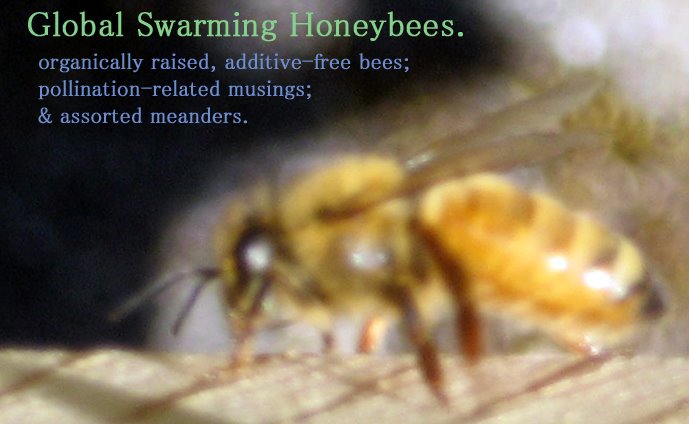Just a reminder of what's at stake.
4.15.2009
8.06.2008
8.05.2008
Jellyfish in a Coalmine
From this week's New York Times article, Stinging Tentacles Offer Hint of Oceans' Decline:
“These jellyfish near shore are a message the sea is sending us saying, ‘Look how badly you are treating me,’” said Dr. Josep-María Gili, a leading jellyfish expert, who has studied them at the Institute of Marine Sciences of the Spanish National Research Council in Barcelona for more than 20 years.
The explosion of jellyfish populations, scientists say, reflects a combination of severe overfishing of natural predators, like tuna, sharks and swordfish; rising sea temperatures caused in part by global warming; and pollution that has depleted oxygen levels in coastal shallows.
6.11.2008
5.19.2008
Bees and Air Pollution—Again
Last week I wrote about an important report from University of Virginia linking air pollution with difficulties among pollinators—including honeybees—in locating the fragrances and chemical signals flowers use to attract pollinators. This is important news, and we're not hearing nearly enough about it in the mainstream media.
Thank goodness for WNYC and other un-bought media outlets with brains in tact. Leonard Lopate interviews the researcher, Professor Jose D. Fuentes, who provides in-depth information on his research and its quite major implications (including its possible correlation with the dreaded CCD). The conversation is fascinating and well worth a listen.
5.07.2008
Our Smog Thwarts Bees
An important and not-at-all surprising new study by Jose D. Fuentes of the University of Virginia shows that air pollution hampers bees' ability to follow the scent of flowers to their source—a clear impediment to the delicate and essential process of pollination upon which our lives (or at least life as we know it) depend.
It doesn't take a rocket scientist to see that the "mystery" of CCD may well be connected to this and the many other environmental insults the honeybees and other pollinators are enduring at our hand. Yes, folks, everything going wrong with the honeybees IS our fault! Canary-in-the-Coalmine Alert, Code Red.
The Washington Post article titled Air Pollution Impedes Bees' Ability to Find Flowers includes the following:
"In the prevailing conditions before the 1800s, the researchers calculated that a flower's scent could travel between 3,280 feet and 4,000 feet, Fuentes said in an interview, but today, that scent might travel 650 feet to 1,000 feet in highly polluted areas such as the District of Columbia, Los Angeles or Houston.
"'That's where we basically have all the problems,' Fuentes said, adding that ozone levels are particularly high during summer. 'The impacts of pollution on pollinator activity are pronounced during the summer months.'
"This phenomenon triggers a cycle, the authors noted, in which the pollinators have trouble finding sufficient food, and as a result their populations decline. That, in turn, translates into decreased pollination and keeps flowering plants, including many fruits and vegetables, from proliferating."
Enough said. (And thanks, S.J., for the tip.)


